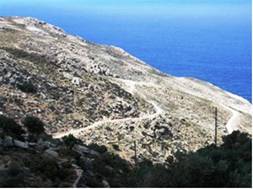Grazing control
Grazing control is a management action aiming at the establishment of equilibrium between herbivores and the resource base of rangelands so that sustained production is ensured. This equilibrium suggests that animal grazing should be practiced so that range condition is maintained at a productive state and rangelands stay healthy. Generally, there are two main systems of grazing a land, namely: (a) continuous, and (b) rotational. In the continuous grazing system, animals remain throughout the grazing land during whole growing period or all the period of the year (Fig. 65). Such a system is beneficial to the animals since they are free to walk around and to select the best plants or plant parts available in the pasture. However, such a system is detrimental for the pasture since plant species do not have the chance to recover and in many cases soil remains partially covered by vegetation for protecting it from the raindrop impact. On the opposite, a rotational grazing system, involves division of the grazing land in pieces allowing the animals graze sequentially over the growing season of the year. Such a grazing control system allows the vegetation to recover and to protect soil from erosion. The following actions have been considered as controlled grazing for this project: (a) selection of a sustainable number of grazing animals, (b) fencing of grazing land and alternatively grazing, (c) avoidance of grazing when soils are very wet, (c) fire protection of grazing land, and (d) other specified. The existing grazing system in each study field site was identified by conducting the land owner.


Fig. 65. Grazing land under continuous grazing subjected to high vegetation degradation and soil erosion (left) and land under the same soil, topographic characteristics but under overgrazing and sustainable grazing systems (right)
As Table 9 shows, data for this indicator have been collected in 1141 field sites, corresponding to 14 study sites. The prevailing grazing system in the study field sites was no grazing control, covering 57.7% of the total fields (Fig. 66). Such grazing system has been identified in the all study sites of Mação- Portugal, Konya Karapinar plain-Turkey, and Eskisehir Turkey, and in several cases in the study sites of Secano Interior-Chile, Cointzio Catchment-Mexico, Boteti Area-Botswana, Santiago Island-Cape Verde, Mamora Sehoul-Morocco, Zeuss Koutine-Tunisia, Novij Saratov-Russia, and Crete-Greece. Sustainable number of animals have been defined almost in the rest of the study field sites (35.3% of the total fields), corresponding to all study fields of Guadalentin Basin Murcia-Spain and in some field sites of Santiago Island-Cape Verde, Mamora Sehoul-Morocco, Gois-Portugal, Zeuss Koutine-Tunisia, Novij Saratov-Russia, Djanybek-Russia, and Crete-Greece. Other grazing systems such as fencing has been identified in few cases (6.0% of the total fields) corresponding mainly in the study sites of Secano Interior-Chile, Boteti Area-Botswana, Mamora Sehoul-Morocco, Zeuss Koutine-Tunisia, and Crete-Greece.

Fig. 66. Distribution of grazing control systems identified in the study field sites